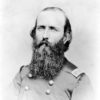calsfoundation@cals.org
Conscription (Civil War)
When the American Civil War began, neither the Union nor the Confederacy relied on conscription to fill the ranks. A draft was not necessary at the onset because men in both the North and the South initially volunteered in large numbers for the war they believed would be over by summer. As the war dragged on through 1861 and into 1862, however, men proved less willing to enlist in the increasingly violent and protracted conflict. For this reason, both the United States and Confederate States enacted conscription in 1862.
The Confederacy was the first to enact compulsory military service. A draft was necessary due to the poor planning on the part of the Confederate government. Recruits had entered military service in large numbers in the immediate aftermath of the firing upon Fort Sumter in April 1861. Twelve months later, the terms of service of these “Men of ’61” were expiring. Should these troops have left military service, the Confederacy would have been deprived of nearly 150 regiments of dedicated and experienced soldiers. After the Battle of Shiloh on April 6–7, 1862—in which nearly 25,000 men on both sides were killed, wounded, or went missing—Confederate leaders realized that additional troops would be necessary. President Jefferson Davis authorized the first Conscription Act on April 16, 1862. This legislation required all white males aged eighteen to thirty-five to serve three years of Confederate service if called. Soldiers already in the military would now be obligated to serve an additional twenty-four months. Five days later, the Confederate government passed the Exemption Act, which excused from military service select government employees, workers deemed necessary to maintain society (such as teachers, railroad workers, skilled tradesmen, and ministers), and owners of twenty or more slaves. Substitution was an additional way to avoid the draft, though the Confederate Congress abolished the unpopular practice in December 1863. However, even before the 1862 Conscription Act, a group of Unionists in Arkansas known as the Peace Society were essentially drafted after their arrest, being given the choice between enlistment or a trial.
Exemption and substitution were just many of the reasons conscription was controversial. Governors considered a draft that assigned soldiers to Confederate national service a usurpation of their state authority. Those who had volunteered in April 1861 and whose enlistments were expiring resented the additional two years of obligatory service. Draftees, who had not volunteered in the initial excitement of 1861 and were less enthusiastic about the Confederate cause, were not eager to leave their homes and families. The first conscription act was only moderately successful, and a second was passed in September 1862. This legislation raised the draft age to forty-five. A third conscription act in February 1864 stipulated that boys of seventeen and men up to fifty would be eligible for reserve duty.
The Union was experiencing similar manpower issues. On July 17, 1862, the militia acts of the late eighteenth century were reinstituted. These laws required all able-bodied men between the ages of eighteen and forty-five to serve in the local units of their state militias. In the decades prior to the Civil War, these laws were rarely enforced; state militias, such as they were, served more as social clubs than military units, with parading and picnicking more common than artillery and musketry drill. In the first year of the war, the militia system was the template to organize volunteer recruits into local regiments. Now, states would be legally required to fill quotas apportioned by the War Department. These troops were to serve for up to nine months. Like the Confederate conscription act, the Union’s state militia draft of 1862 achieved only moderate results. A more permanent procedure would be needed to provide necessary troops. To this end, President Lincoln signed the Enrollment Act on March 3, 1863, which called for a Federal draft that summer. Federal conscription was wildly unpopular and led to violence in many locales, most famously in New York City, where eleven African Americans were killed by angry mobs in July 1863. Immigrants and the poor were especially resentful of the methods used by wealthier citizens to avoid service.
The draft was especially problematic and difficult to enforce in Arkansas, and figures for Union and Confederate conscription are difficult to quantify. The Union victory at the Battle of Pea Ridge one month prior to the enactment of Confederate conscription meant that the pro-Confederate administration of Governor Henry Rector no longer had full autonomy statewide. Too, resistance to Confederate conscription was noteworthy in the highlands of Arkansas, where there was little investment in slavery; in the Ouachita Mountains, men who had avoided conscription efforts fought with Confederate forces in the February 15, 1863, Skirmish at McGraw’s Mill. Neither the North nor South exercised full control within the state through the remainder of the war. Regardless, the primary purpose of conscription, in Arkansas and elsewhere, was never to raise substantial numbers of troops but to spur enlistment. In this aspect, at least, Union and Confederate conscription achieved some success.
For additional information:
Kirwan, Albert D., ed. The Confederacy. New York: Meridian, 1959.
Moore, Albert B. Conscription and Conflict in the Confederacy. New York: Macmillan, 1924.
Murdock, Eugene C. Patriotism Limited, 1862–1865: The Civil War Draft and the Bounty System. Kent, OH: Kent State University Press, 1967.
Sacher, John M. Confederate Conscription and the Struggle for Southern Soldiers. Baton Rouge: Louisiana State University Press, 2021.
Shannon, Fred A. The Organization and Administration of the Union Army, 1861–1865. 2 vols. Cleveland: The Arthur H. Clark Company, 1928.
Keith Muchowski
New York City College of Technology (CUNY)
 Civil War Recruitment
Civil War Recruitment Civil War Refugees
Civil War Refugees Civil War Timeline
Civil War Timeline Military Board (Civil War)
Military Board (Civil War) Union Occupation of Arkansas
Union Occupation of Arkansas




Comments
No comments on this entry yet.